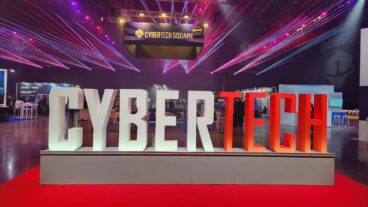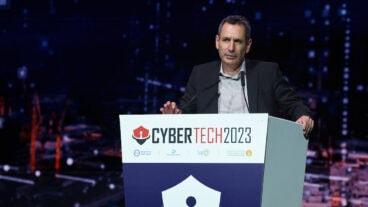The Core 2 Duo microprocessor – ‘Risk taking is part of our value,’ says Shmuel Eden, former head of the Intel Israel Development Center.Five hundred employees and guests crowded under a white tent half the length of a football field at Intel Corp.’s Santa Clara, California, headquarters as Chief Executive Officer Paul Otellini put his company’s newest line of computer chips through their paces.
“These are the best microprocessors we’ve ever designed, the best microprocessors we’ve ever built,” Otellini told the audience. “This is not just incremental change; it’s a revolutionary leap.”
Otellini’s pronouncement relegated to obsolescence Intel’s Pentium chip, which once powered more than 80 percent of the world’s personal computers. That wasn’t the only surprise last July.
A camera zoomed in on engineers in lab coats in Haifa, Israel. The video revealed that the chip Intel is counting on to recover from a battering by Advanced Micro Devices Inc. wasn’t invented in Silicon Valley. Instead, Intel is betting on a group of Israeli mavericks and a design bureau 7,400 miles away.
Shmuel Eden, former head of the Israel Development Center where the new Core 2 Duo was created, says he’s fed up with the perception that Intel’s prowess is fading.
“People are angry,” says Eden, who moved to Santa Clara in 2002 as sales manager for Intel’s laptop chip division. “When I see something in the press saying Advanced Micro has taken our lead in technology, it hurts me personally.”
Investors are hurting too. “I can’t see Intel getting back to the market share levels they used to have,” says William Gorman, an analyst at Philadelphia-based PNC Wealth Management, which manages about $50 billion, including Intel shares. “They opened a window, and AMD took advantage.”
Intel’s share of the $33 billion computer processor industry is the lowest in 11 years, according to Cave Creek, Arizona-based Mercury Research. Profit plunged 42 percent to $5.04 billion last year as the company slashed prices after Intel’s share of the personal computer processor market slipped to 75 percent.
Advanced Micro, Intel’s Sunnyvale, California-based rival, unveiled its first server processor, called Opteron, in 2003. Since then, Advanced Micro has wrested customers away from Intel. One, the Philadelphia Stock Exchange, switched its servers to Opteron in 2005 and then chose Advanced Micro-powered computers for its network of 600 desktop machines.
“When I find a technology that works for me, I’m going to stick by it,” says Gene Peters, director of information services at the exchange. “I’ve no doubt that we made the right choice and will be with it for the next five or six years.”
Without customers like Peters, Intel’s sales dropped 9 percent last year to $35.4 billion, even as the PC market grew 10 percent. Dell Inc., Intel’s largest customer, compounded the woes last May by ending its exclusive use of the company’s chips.
Intel shares finished 2006 down 19 percent, the worst performance in the Dow Jones Industrial Average. That includes the 16 percent rise that began on July 27, the day Otellini unveiled the Israeli-designed processor. Intel shares have fallen 5.9 percent in 2007 as of March 27.
Once the second-largest technology company by market value, behind Microsoft Corp., Intel is now fifth – overtaken by No. 2 Cisco Systems Inc., No. 3 Google Inc. and No. 4 International Business Machines Corp.
“I just can’t get excited about what’s going on,” says Daniel Morgan, who helps manage $5.45 billion, including Intel shares, at Columbus, Georgia-based Synovus Investment Advisors. “Do they ever regain the prominence and bellwether status that they achieved during the ’90s?”
That answer would be a definite no if not for the Israeli team, says Doug Freedman, an analyst in San Francisco for Greenwich, Connecticut-based brokerage American Technology Research.
“They saved the company,” Freedman says. “Without those new products, Intel would be in a lot more trouble.”
Otellini’s bet on the Israelis required a shift in thinking about how processors work -and how Intel markets them. Intel had always promoted the mantra that faster clock speed, the rate at which a chip executes instructions, was the key to measuring how well a computer performs.
Compaq Computer Corp., now part of Hewlett-Packard Co., and others sold PCs with the Intel Inside logo, banking on speed. In 1986, Compaq called a PC with Intel’s 386 processor “blazing.” It ran at 33 megahertz, or 33 million cycles per second.
In 2000, when Otellini unveiled the Pentium 4, Intel compared that chip with the company’s 4004 model from 1971. If automobile speed had increased at the same pace, people would be driving to New York from San Francisco in about 13 seconds, Intel boasted. Advanced Micro escalated the speed wars with a new version of its Athlon chip, calling it “the PC industry’s equivalent of breaking the sound barrier.”
Otellini, then head of Intel’s microprocessor division, upped the stakes in 2001. He said future Pentiums would run at 10 billion cycles per second, quadruple the pace of the fastest processor of the day.
“Intel expects this architecture to scale to 10 gigahertz and beyond,” Otellini said in typical geek fashion. He declined to be interviewed for this article.
Eden, who prefers a beret and a leather jacket to Intel’s unofficial uniform of a blue shirt and khakis, says the Israeli team realized the danger in the industry’s obsession with speed. For decades, making chips perform better had meant cramming transistors closer together and switching them on and off more quickly.
After almost 40 years, the postage stamp-size devices contained millions of transistors flickering more than a billion times a second. The penalty was heat – as much as generated by a small television set.
As Eden and the Israelis contemplated computer makers’ designs for thin and light notebooks, they realized they’d need a fan thicker than the computer itself to keep the processors from cooking. That would make slim laptops impossible.
“We hit the power wall,” Eden, 53, says. “We said, `Guys, it cannot work anymore.”’
It wasn’t the first time the Israelis had faced a challenge and decided to do things their way. “The fact that we were in a remote location definitely enabled us to make whatever we wanted,” says Eden, who in June 2005 continued his analyst briefing on laptop technology after toppling off the stage at the Grand Hyatt Hotel in San Francisco.
“Innovation won’t grow in a nice, disciplined environment,” he says. “Risk taking is part of our value.”
Chip designer Dov Frohman says he tried to convince Andy Grove and Gordon Moore to hire engineers in Israel back in 1966 as the pair prepared to leave Fairchild Semiconductor Corp.
“I’d been bugging Grove and Moore to set up an operation in Israel,” says Frohman, now 67, who’d gotten his bachelor of science degree in 1963 at the Israel Institute of Technology in Haifa. The university is known as Technion.
Frohman followed Robert Noyce, Grove and Moore out of Fairchild. Noyce and Moore founded Intel, and Grove joined as the second employee. Frohman reunited with his Fairchild colleagues at Intel in 1969.
He made the first major Israeli contribution to the young company in 1971, inventing erasable programmable read-only memory chips, known as EPROM. Before that, computer makers had to throw away chips and replace them with new ones if they wanted to change their functions. EPROM helped drive Intel’s sales to $66 million in 1973 from $9 million in 1971.
Frohman persuaded Grove to sign off on a center in Israel in 1974 – and went on to become general manager of Intel Israel until he retired in 2001. He pushed for a location near Technion to take advantage of a supply of engineers and the cachet of the university, which Albert Einstein helped found in 1924.
The outpost put itself on the map in 1981 when the Israelis created a cheaper version of Intel’s 8086 processor, renamed the 8088. In 1981, IBM chose the chip to power its first personal computer.
A decade later, Frohman kept the Israeli bureau running during the first Gulf War, ignoring what he says was an Israeli government directive to shut down. Some 80 percent of Intel’s workers reported to the job in the face of feared chemical attacks as Iraqi Scud missiles landed in Haifa and Tel Aviv in January 1991, he says.
“My concern wasn’t only for the survival of Intel Israel,” Frohman said in an account in the `Harvard Business Review.’ “It was also for the survival of Israel’s high-tech sector.”
Today, Israel has more scientists and engineers, proportional to its population, than any other country – 145 for every 10,000 people compared with 85 per 10,000 in the US, according to ISRAEL21c, a nonprofit organization aimed at teaching Americans about Israel.
In the US, Grove, who’d fled communist rule in Hungary in 1956, was cultivating his own brash style. As Intel’s chief operating officer since 1976, he’d faced off with managers in what he called “constructive confrontations.” Participants had a different term: “the Hungarian inquisitions.”
“Don’t sit on the sidelines waiting for senior people to make a decision so that you can later criticize them over a beer,” Grove wrote in his 1996 management primer, `Only the Paranoid Survive.
The Israelis took Grove’s in-your-face model to the max. David Perlmutter, who’d graduated from Technion and joined the Haifa bureau as a chip designer in 1980, recalls one of the first visits by an American colleague.
“He was waiting in my office next to the meeting room,” Perlmutter says. “When we all emerged from the room, red faced after shouting, he asked me what was wrong. I told him, `Nothing. We reached some good conclusions.”’
Perlmutter, 53, is now based in Santa Clara. As senior vice president of the mobility group, he’s responsible for Intel’s mobile computing division, which produces a third of the company’s revenue.
“When I go back to Israel, it’s like going back to the old culture of Intel,” he says. “It’s easier in a country where politeness gets less of a premium.”
Eden joined the Haifa office in 1982 after graduating from Technion in 1973 and working for Tadiran Communications Ltd. in Holon, Israel, which makes military radios. He moved up to head the development center in 1999.
At that time, the Israelis were out of the mainstream as Intel rode the dot-com wave. Intel’s shares jumped 47 percent from June 30 through Sept. 9 that year on expectations that PC demand would soar. The shares traded at $37.16 on Sept. 30, 1999, roughly double their price on March 27, 2007.
In Haifa, Rony Friedman was working on a chip for low-cost computers. It was slower than Intel’s existing lineup – but it put out less heat. The chip divided up instructions into parts and carried out the instructions in tandem. The design allowed the chip to run software faster and use less power.
The Israelis thought they’d hit the jackpot. Intel didn’t. Otellini canceled the project because the chip worked with a special kind of memory that was too expensive.
“We weren’t the mainstream,” says Friedman, seated in his office in the Haifa design center, about a half hour from Technion. The center is a smaller version of Intel’s Santa Clara headquarters down to its rows of gray fabric-lined cubicles.
“At the time, frequency was king,” Friedman says, referring to clock speed. “We were on the outside.”
The trick was to persuade the rest of Intel that the company could sell a slower processor to consumers and PC makers. Winning over Otellini, then head of the chip division, proved a turning point.
“We did it the Israeli way; we argued our case to death,” Eden recalls. “You know what an exchange of opinions is in Israel? You come to the meeting with your opinion, and you leave with mine.”
The Israelis’ new chip, named Banias after a river in northern Galilee, got a break with Intel’s push into notebook computers.
It hit the market in March 2003 as part of a laptop package called Centrino. The fastest processor was a 1.6-gigahertz model that sold for $720. Banias had a slower clock speed and was more than double the price of the 2.8-gigahertz Pentium that Intel sold for $278 two months later. It let business travelers tote around PCs that had the same performance as their desktop models. Banias anchored three years of 13 percent annual sales growth at Intel from 2003 to ’05.
The trouble was that while Intel was working on laptop chips, Advanced Micro CEO Hector Ruiz persuaded IBM to use the Opteron processor for servers. By the end of 2006, Advanced Micro had snatched about a quarter of the server market, up from about 4 percent before Opteron came out in 2003, according to Mercury Research.
By proving it could deliver chips reliable enough to run critical functions – and not just home PCs – Advanced Micro cast off its past reputation as a cheap second source for Intel parts.
“Computer makers have an alternative in the microprocessor that they’ve never had before,” says Cody Acree, an analyst at brokerage Stifel Nicolaus & Co. in Dallas. “They’re going to take advantage of that.”
Acree expects that, in time, the microprocessor market will look more like a 50/50 world – evenly divided between Intel and Advanced Micro – than an 80/20 world.
Intel’s type-A personalities are rallying against the prospect of demotion to equal status with Advanced Micro. In one 100-day period last year, Intel introduced more than 40 new processors.
Most of them are based on the Israeli design, says Senior Vice President Patrick Gelsinger, who heads Intel’s digital enterprise division, which makes chips for corporate computers. Gelsinger’s unit provides more than half of Intel’s sales.
“It’s been a great year, coming off a pretty ugly 2004 and 2005,” he says.
With the end of the Pentium, Gelsinger, 46, will see the disappearance of the last of the chips he helped design in his 28-year Intel career. He started at the chipmaker at age 18. He got his bachelor of science degree in electrical engineering at Santa Clara University while working at Intel. He went on to earn his master of science in the same field from nearby Stanford University.
Now, Gelsinger’s division has to deliver a new design, based on the Israelis’ Core 2 Duo. “It’s creating a healthy rivalry,” says Gelsinger, gripping Perlmutter’s shoulder at a December round table with Intel executives in San Francisco.
For now, Core 2 Duo is making headway against Advanced Micro. Intel gained back about a percentage point of market share in chips for server computers in the fourth quarter, according to Mercury Research.
One investor says Intel can grab a lot more. “They’re really going to be very competitive versus AMD,” says David Goerz, who manages $20 billion, including Intel shares, as a senior vice president of Highmark Capital Management in San Francisco.
Goerz’s expectation puts Intel’s Israelis in the spotlight – an unfamiliar role.
“It’s unbelievable that, just a few years ago, we were designing something that no one wanted,” Friedman says.
Still based in Haifa, Friedman now runs Intel design groups around the world after his initial foray pointed the company in its new direction with the canceled chip for low-cost computers.
“Now we’re doing processors that should carry most of Intel’s revenue,” he says. “We can’t screw up.”
(Copyright 2007 Bloomberg L.P. All rights reserved. Reprinted with permission)












